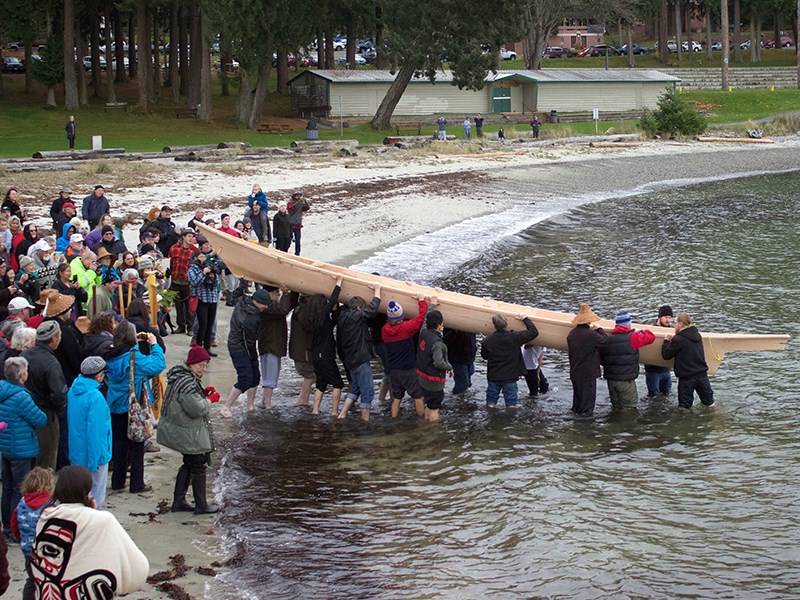After capturing the attention of Powell River residents for 59 days, Hɛhɛwšɩn (The Way Forward) Reconciliation Canoe Journey Project continued with a blessing of the finished canoe before it was carried into the cold waters at Willingdon Beach.
The first dip of the paddles into the ocean and presentation of the canoe to Tla’amin Nation on November 18 signified a continuation rather than a completion.
Hɛhɛwšɩn is the beginning of a seven-generation journey, said Phil Russell, one of the project’s principal organizers. Russell spearheaded the idea for the non-indigenous community to gift the canoe to Tla’amin.
“We’re learning for the first time the history of the indigenous peoples, what they've been put through and the impacts that have been intergenerational on them,” said Russell. “To have both communities come together is not going to be easy; there's a lot of damage done and trauma they went through that has never been discussed. We're on the start of a journey saying that in seven generations we hope to make this a different place.”
Russell said that even with the best of intentions and hope, reconciliation is going to take time. That view is shared by many others, including Tla’amin citizen Melvin Mitchell.
“This is just the first step in not only learning for our kids, who will be paddling the canoe, but for all the people who are all here to see this,” said Mitchell. “When the canoe does go on its first journey, people are going to feel they had a part in helping to shape our kids’ future, to have them go back in time to when everybody shared and cared and looked after each other; there's so much of that not in this world anymore.”
About 250 people lined the shore of Willingdon Beach for the launch. After the gifting ceremony, the canoe was transported to Tla’amin where a celebratory luncheon was held.
According to School District 47 coordinator for outdoor and ecological learning Ryan Barfoot, the two communities’ approach to the reconciliation movement on Tla’amin traditional lands was grassroots and personal from the beginning.
Barfoot said the premise was that the more people the carving project involved, the more conversations and reconciliation would come from it. Most pertinent for the future is its relation to youth and education, he added.
More than 1,000 students from kindergarten to grade 12 contributed to the process.
For Tla’amin citizens, the canoe represents far more than just dialogue between indigenous and non-indigenous people. It carries cultural history and traditional teachings.
Tla’amin paddlers will take Hɛhɛwšɩn up and down the Pacific Northwest coast on yearly canoe journeys of rediscovery where thousands of first nations people gather at host communities to take back their culture, according to Tla’amin citizen Scott Galligos.
“This canoe is going to help heal,” said Galligos. “It's medicine to our people.”
Many of the Tla’amin citizens who spoke of the significance of the Hɛhɛwšɩn project during the gifting ceremony emphasized the canoe’s properties of restoration and renewal that are deeply felt by people who travel on the journeys.
“Some of them are healing, some are in the grieving process and some are battling addictions,” said Galligos. “The canoe journey transforms people. We brought youth at risk on our canoe this year and they came out of their shells; they were singing, sharing in circles, dancing and listening.”
Several metaphors have been used to describe the Hɛhɛwšɩn project, including that it allows for time travel, according to Mitchell.
“It’s a time machine that goes back in time to teach the kids respect,” said Mitchell. “When you go on the canoe journey, it's a learning journey. You learn about yourself and self respect and you respect the community, and more, when you get home.”
Many of those in attendance at the canoe launch were caught up in the emotion of the event. Galligos said his heart was full and City of Powell River councillor Rob Southcott said he was so happy he cried.
Southcott called the project a landmark in reconciliation.
“There will come a time when we look back at this juncture as being exactly that,” said Southcott. “It’s a huge turning point of reawakening to this large community’s birthright here and we're awakening to that again. I'm deeply grateful for living at this time.”
Southcott was part of a group who had an opportunity to carry the canoe.
“It's an experience we all want to share because we can't imagine until we've touched it,” he said.
School District 47 educator Chris Bratseth said the project is an evolution of the community. Bratseth said he sees the Hɛhɛwšɩn project from the perspective of having an awareness to take action.
“It's remarkable to have grown up here and, having left for a decade, coming back to see a community celebrating something that is kind of at the root of what this community is,” said Bratseth. “We're slowly peeling back the layers of what the true history is of this place. As someone who grew up here, it’s amazing.”
While there was celebration and meaning associated with the Hɛhɛwšɩn Reconciliation Canoe Journey project, reconciliation is more than a canoe. Continuing to move forward will not be easy and mistakes or pitfalls along the journey are inevitable.
“We need to be cautious we do not romanticize reconciliation,” said city councillor and Powell River Métis Society president Russell Brewer. “It will require ongoing conversations to change perspectives and establish respectful relationships, but it will also require substantive actions by individuals and communities to change behaviours and demonstrate real societal change.”



